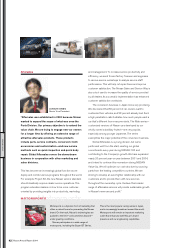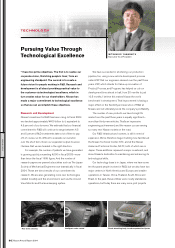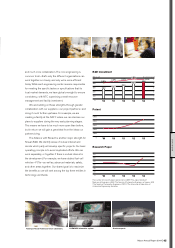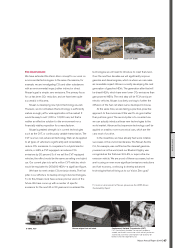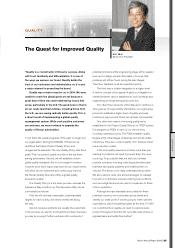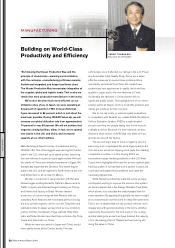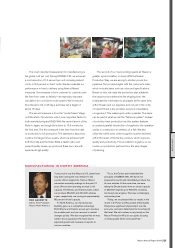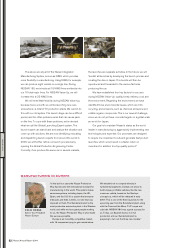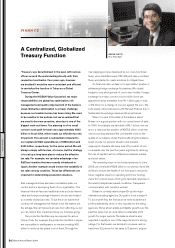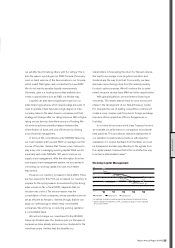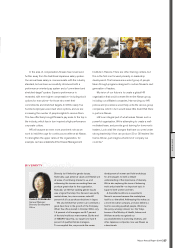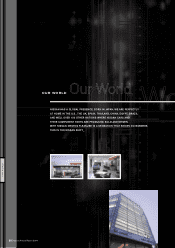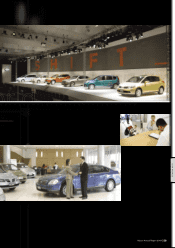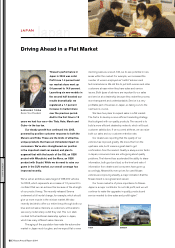Nissan 2005 Annual Report Download - page 54
Download and view the complete annual report
Please find page 54 of the 2005 Nissan annual report below. You can navigate through the pages in the report by either clicking on the pages listed below, or by using the keyword search tool below to find specific information within the annual report.
Nissan Annual Report 2004
52
“In the last four years the Nissan Production
Way has become the international standard for
manufacturing in the world. This system makes
sense everywhere, including Japan, the UK,
Spain, and the U.S. It’s a system that everyone
embraces and feels is theirs, not one that was
imposed on them. The Sunderland plant is the
most productive automotive plant in the Western
world, and while we have great people working
for us, the Nissan Production Way is what made
this success possible.
Europe is an incredibly competitive market,
with 15 companies trying to gain market share.
We decided not to compete directly in
fundamental segments. Instead, we chose to
build unique, profitable vehicles, like the new
crossover vehicle, based on the Qashqai
concept car, which will be released in early
2007. This is one of the three launches for the
upcoming year from the Sunderland plant, along
with the Tone and the Micra C+C coupe and
cabriolet. NISSAN 180 was a great success for
us. Today, our Spanish factory is in full
production and our Sunderland plant is
preparing to turn out the three new models.”
COLIN DODGE
Senior Vice President
Nissan Europe
EEuurrooppee
MANUFACTURING IN EUROPE
OUR WORK
The above are all part of the Nissan Integrated
Manufacturing System, known as NIMS, which provides
more flexibility in manufacturing. Using NIMS, for example,
we can produce eight models on a single line. During
NISSAN 180, we introduced 16 NIMS lines worldwide into
our 18 total major lines. For NISSAN Value-Up, we will
increase this to 22 NIMS lines.
We will need that flexibility during NISSAN Value-Up,
because twice a month we will be launching new cars
somewhere—a total of 70 production starts. We cannot do
this with our old system. The launch stage can be a difficult
period, and too often problems arise that can cause panic
on the line. To cope with these problems, we’ve devised
what we call the Global Launching Expert system. The
launch expert can stand back and analyze the situation and
come up with solutions. We are now identifying, educating
and dispatching launch experts from around the world. In
2006, we will further refine our launch procedures by
opening the Global Production Engineering Center.
Currently, if we produce the same car in several markets,
the launches are separate activities. In the future, we will
‘bundle’ all launches by developing the launch process and
creating the dies in Japan. This bundle will then be
reproduced and forwarded to the various factories
producing the car.
We have established four key factors for success
during NISSAN Value-Up: quality, timely delivery, cost, and
the environment. Regarding the environment, we have
identified three environmental issues, which are CO2,
recycling, and emissions such as chemical emissions and
volatile organic compounds. This is our newest challenge,
since we do not yet have concrete targets on a global scale
as we do for Japan.
Our goal is to maintain Nissan’s status as the world
leader in manufacturing by aggressively implementing new
technologies and expertise. Our processes are designed
to require low investment costs and generate fast product
launches, which would result in a faster return on
investment in addition to a top-quality product.”


